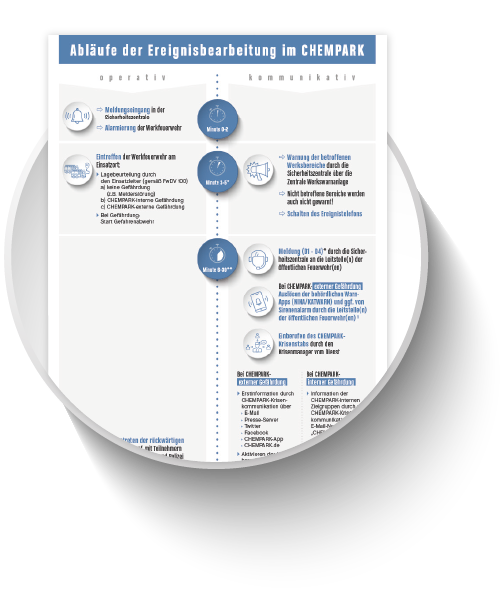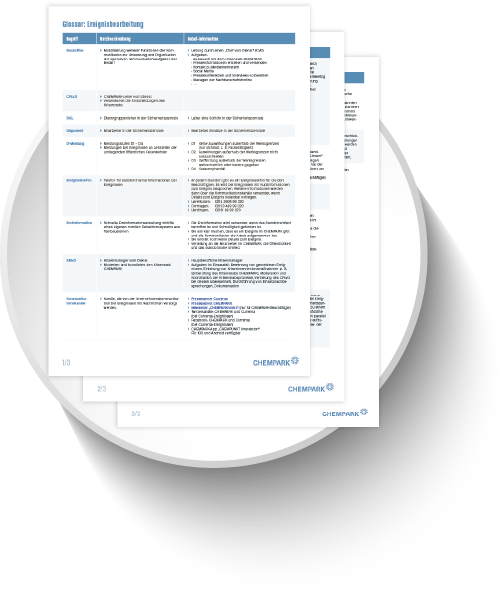Safety for employees and visitors
Thanks to extensive safety measures, incidents at the CHEMPARK are extremely rare. However, safety can never be absolute. An event cannot be ruled out with absolute certainty. For quick information in case of an event, you can subscribe to our newsletters here to be informed by email in case of an event.
Be prepared
This is what you can do in general
Save the emergency numbers of the security center in your cell phone
Employees at the CHEMPARK can use their company e-mail address to subscribe to our "CHEMPARK internal" information service.
For employees of CHEMPARK partners
Employees within the CHEMPARK please register here to be informed quickly by e-mail in the event of an incident. Please note that we use the domain of the mail address to check whether these are really employees of CHEMPARK partner companies.
Behavior in the event of an incident
Notes for visitors,Employees of partner companies andEmployees at CHEMPARK Leverkusen
Alarm sounds inside the CHEMPARK
"External danger" alarm tone (horn tone)
"Internal danger" alarm tone (crash tone)
Perceptions
- Odors, e.g. gas/fire odor
- optical perceptions, e.g. cloud of smoke
- unusual noises, e.g. loud bang
Alerting the security forces
If you notice an irregularity – and no action by the security forces is yet apparent – please report it immediately to the security center:
- via landline: emergency call 112
- by mobile phone at LEV: 0175 – 30 99 399 | DOR: 0175 – 31 39 939 | UER: 0175 – 31 19 939 (Please save this number in your mobile phone!)
- or inform the nearest company
Warning signals
- Warning systems: Observe the warning signals of the
Central plant warning system (ZWA) and the warning signals
or warnings of the respective operation as well as
its alarm order! - Loudspeaker announcements of the security forces
- Light signals
- Signs
- mobile barriers
Safety instructions for behavior outdoors and indoors
- stay away from the scene of an accident
- Leave danger zone
- go to a building that is not affected and report
inside - Close windows and doors
- Switch off ventilation and air conditioning
- In case of contact with hazardous substances or in case of inhalation of hazardous substances: Call an ambulance.
(Landline: Emergency 112 or mobile phone: LEV 0175 – 30 99 399| DOR 0175 – 31 39 939| UER 0175 – 31 19 939) - Follow instructions of the staff
Behaviour in the car
- Close windows and doors
- Switch off ventilation and air conditioning
- Leave the danger zone, if possible
- Follow instructions of the staff
Information in the event of an incident
To receive information by telephone, dial
Was passiert, wenn im CHEMPARK etwas passiert:
If something happens at the CHEMPARK, what would be the cause of events?
If a call to the security centre at the CHEMPARK – SiZe for short – is classified as an emergency call, an alarm is immediately sent to the emergency medical services and/or the site fire department. On arrival at the scene, the emergency services assess the situation and – if necessary – instruct further hazard prevention measures. If a hazard outside the plant boundaries cannot be ruled out, messages may go out minutes later via the official warning apps such as NINA or KATWARN. And this despite the fact that no communication has yet taken place at the CHEMPARK itself. How can this be? A schematic diagram shows the event processing sequences and explains the procedure and interrelationships.
Minute 2 to 5 after alarm input
Between minute 2 and minute 5 after the alarm is raised, the site fire department arrives at the scene. Immediately upon arrival, the incident commander makes an assessment of the situation, which he immediately reports to the SiZe and instructs – if necessary – all necessary hazard prevention measures.
The SiZe warns the affected plant areas via the central plant warning system (ZWA). A SiZe employee activates the warning with a mouse click. The warning also switches the event phone, which provides brief information.
In fact, the plant’s internal warning is issued as quickly as possible and always arrives before an official warning. However, warnings are only issued where they are necessary because of a possible hazard. Plant areas not affected do not receive a warning with behavioral instructions from the SiZe, but later receive initial information via the “CHEMPARKintern” e-mail newsletter (for CHEMPARK companies only) from Crisis Communication. In order to understand why the initial information cannot be created at the same time as the warning, one must take a closer look at the processes in minute 6 to minute 30 after the alarm is received:
Minute 6 to 30 after alarm input
On the basis of the information provided by the incident commander, the incident commander classifies the event into a four-stage D reporting level system and reports this to the control centres of the responsible public fire brigades:
- D1: The event has no effect outside the factory boundaries. This can be the case, for example, with flaring gases or loud noises that are perceptible from the outside and could be considered dangerous, but objectively are not.
- D2: Impacts outside the plant boundaries cannot be ruled out.
- D3: A hazard outside the plant boundaries is likely or has already occurred.
- D4: Disaster case.
The D-message from the SiZe is the basis for the public fire brigade to decide on the triggering of the official warning systems for certain geographical areas. These include warning apps such as NINA and Katwarn, but also the siren alarm: the characteristic on and off wailing sounds are still one of the most effective ways of warning the population today. This was made particularly clear once again by the flood disaster in the Ahr valley and the Eifel region.
The purpose of the warning is to draw the attention of those concerned to the imminent danger or to create an awareness of an existing dangerous situation and thus to avert or minimise possible damage. The increasing use of warning apps for information purposes is therefore problematic. The greater frequency with which the warning app thus reports to the users inevitably leads to a communicative desensitisation. In an emergency, attention is then less or the warning is ignored as supposedly irrelevant information.
While the emergency response measures are underway at the scene of the incident – depending on the scope and nature of the event, also with the support of public fire brigades, police, THW, etc. – the so-called “rear command” meets at the police station. This command staff for the operational-tactical task forces takes care of supplies, logistics and everything else that the task forces need on site for the best possible hazard prevention. Representatives of the police and public fire brigades are also involved. The work of the rear command follows a control loop of situation assessment, situation evaluation with all its options and risk/benefit considerations, determination of measures and subsequent implementation.
Meanwhile, the crisis manager on duty convenes the crisis team. This also activates CHEMPARK crisis communication. Initial information is now being prepared in coordination with the crisis manager. This is done very quickly – not least thanks to a mobile editorial system developed by CURRENTA itself. In seconds, this is clicked together from text modules and distributed to the employees at the Chempark as well as the public and the surrounding area close to the site: CHEMPARKintern” e-mail newsletter (only for CHEMPARK companies), neighbourhood offices, Chempark app, Twitter and Facebook, press. Distribution lists for internal and external target groups, local, regional or nationwide, are stored. If necessary, other communication functions are now mobilised to implement and organise the upcoming operational communication tasks.
Prior to the initial information, there are basically more steps in incident handling than prior to the triggering of the NINA warning by the public fire brigade. Those who know this are not surprised that the initial information goes out at best parallel to the public warning, but usually follows it. This is no cause for concern: by definition, it is not intended as a warning, but contains the event message itself and recommendations for behaviour.
Minute 31 to 60 after alarm input
It is understandable that some people find the initial information too thin. Because: Anyone who has noticed the fire brigade moving out with its siren and blue light and has already received the external NINA warning naturally wants to know more. Especially when the first videos of the event are circulating on social media or friends and acquaintances work in the affected area of the factory. However, in order for CHEMPARK crisis communication to continue to provide information on a sound factual basis, detailed situation information is needed from the crisis team.
The crisis team meets for the first time between minutes 31 and 60 after the alarm is received. It takes care of all administrative and organisational tasks that arise in connection with the event but do not serve the direct prevention of danger. Staff members from the areas of site security, permits and crisis communication are an integral part of the team, along with the crisis manager on duty, who heads the staff, and the CHEMPARK head on duty, who is responsible for decision-making. Fire protection is always firmly represented for the transmission of the situation picture. In addition, there are occasion-related members as expert advisors, e.g. for infrastructure, medical issues, etc. The company concerned is also represented.
Normally, the crisis team works directly at the affected site in the station. This ensures short distances to the security centre and the rear command. In order to ensure the ability to act even in special situations – impeded access due to motorway closures, tightened pandemic conditions – partially or completely virtual alternatives to the face-to-face format are also possible. Irrespective of format, the crisis team works according to the same control cycle as the rear command: situation assessment, situation evaluation, definition of measures, implementation. The crisis team meetings follow the rhythm of the emergency management meetings with a time lag.
As a rule, the CHEMPARK crisis communications team has two members: a member of staff in a strategic advisory role and a member of staff who takes care of the operational crisis communications work (“chief of staff”). In this way, more detailed information can ideally be prepared in the crisis team meeting, adopted and published on all communication channels before the end of the first hour after the alarm is received. Between the crisis team’s camp rounds, the chief of staff manages the implementation of the other communication tasks: Contacting the media, managing the neighbourhood hotline and neighbourhood offices, media monitoring, extended information gathering, etc.
After the first hour
Due to the process, initial detailed information based on a secure factual situation cannot normally be expected within the first hour after the event. But that also makes it clear: no one else will make it sooner. Even if faster news about the event appear on social media or any other sources – they cannot be checked, evaluated and interpreted correctly. Such quick speculations help no one, fuel the rumour mill and, at worst, create “sideshows” that further increase the workload of crisis communication at inopportune times.
Reliable first-hand information
Findings from the operational communication work – number and content of hotline calls, press enquiries and media coverage, etc. – flow back to the crisis team from the second round of camps. The results of the crisis team meetings, which are always linked to the meetings of the rear operations management, continue to feed the CHEMPARK crisis communication messages. This integration of communication into the crisis management structure creates the prerequisite for the best quality and highest speed of information.
Procedures for events

Glossary
